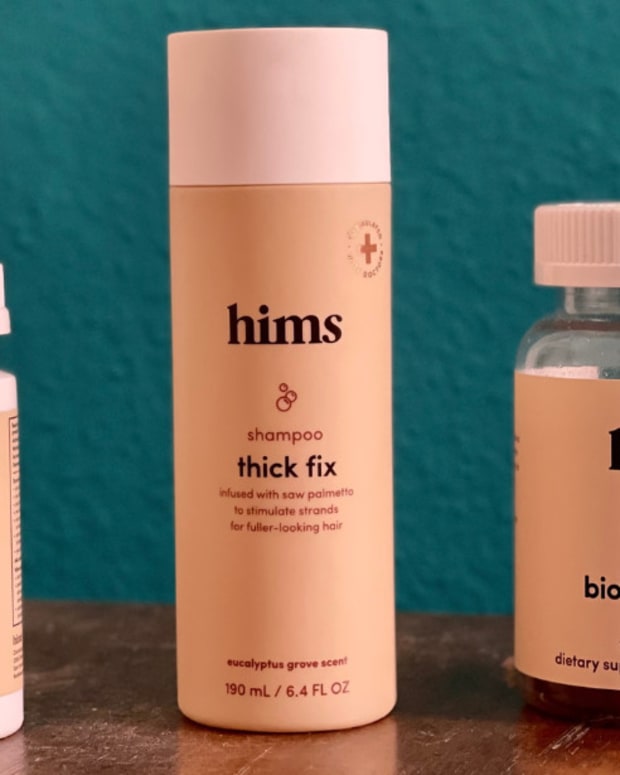The products featured in this article have been independently reviewed. When you buy something through the retail links on this page, we may earn commission at no cost to you, the reader. Sports Illustrated editorial staff are not involved in the creation of this content. Learn more here.
Prebiotics, probiotics, postbiotics, synbiotics—the supplement aisle is filled with so many different “-biotics” claiming to revolutionize gut health that it can be difficult to know what’s what.
Prebiotics are actually a food source for the bacteria in your gut. Good bacteria are able to digest and ferment these compounds, which allow them to grow healthier and to produce good-for-you chemicals that offer several health benefits.
Before prebiotic supplements hit the market, most of the prebiotics we consumed came directly from fiber-rich foods. Here, we’ll provide an overview of prebiotics and their benefits, along with some of the best natural, food-based sources of prebiotics. If you’re not sold on these dietary options, we’ve also rounded up supplements you can add to your diet.
This content is meant to be informative, but should not be taken as medical advice. It is not intended for use as diagnosis, prevention or treatment of health problems. Always speak with your doctor before starting any new supplement or exercise regimen.
What Are Prebiotics?
Prebiotics, not to be confused with probiotics (which are supplements that contain live bacteria), are fibers that our bodies aren’t able to digest by themselves. However, the bacteria that reside in our large intestines are able to digest these fibers—so prebiotics are considered a valuable food source for them.
When beneficial bacteria digest prebiotics, they produce short-chain fatty acids (SCFAs) such as butyrate. It’s thought that many of the benefits of probiotics and prebiotics actually come from SCFA production.
SCFA supplements are often called “postbiotics” for this reason—and synbiotics are supplements that contain prebiotics, probiotics and postbiotics.
One of the most beneficial types of prebiotic is known as fructo-oligosaccharide (FOS) prebiotic or fructan. This is the type of prebiotic that’s found in most prebiotic supplements or prebiotic-enriched foods. However, it’s only found in natural foods in small amounts.
Related Post: What Is A Prebiotic?
Benefits of Prebiotics
Prebiotics offer several potential benefits.
The most straightforward effect of prebiotics is that they promote the health and proliferation of healthy strains of bacteria in the gut. They also help to increase the amount of SCFA being produced.
According to a 2021 review in Biomolecules, prebiotics may contribute to:
- Improved nutrient absorption
- Lower triglyceride and cholesterol levels
- Stronger immune system responses
- Reduced inflammation and cellular stress
- Better gut lining integrity
- Improved mood and brain function
- Digestive regularity
- Protection against allergies and asthma
- Improved metabolic health and weight management
- Better vaginal health in women
Why Are Prebiotics Important?
Prebiotics, like probiotics, can help promote a healthier balance of gut microbes and enhance the production of short-chain fatty acids.
Because gut health plays such a key role in digestion, immune support, brain function and metabolism, including fiber-rich prebiotic foods in your diet is an important consideration for your overall health.
Unfortunately, eating these foods in their most natural, minimally processed state won’t provide huge amounts of prebiotics. However, foods rich in prebiotics are typically healthy for you in a number of other ways—so prebiotics aren’t the only reason to eat them.
Prebiotic Foods To Add to Your Diet
Prebiotic foods are naturally rich in fiber, minimally processed and loaded with good-for-you nutrients and antioxidants. That makes them an excellent addition to your diet, even though these foods aren’t particularly high in FOS prebiotics.
Here are some of the best prebiotic foods.
Chicory root
Chicory is a plant in the dandelion family. Chicory root isn’t a commonly eaten food, but it’s a surprisingly good source of the beneficial FOS prebiotic inulin.
The most well-known use of chicory root is actually as a coffee substitute. You can easily find premade chicory coffee and chicory coffee blends in certain parts of the country, particularly the Southeastern U.S. If it’s available in your area, you may also be able to find whole chicory root at specialty grocery stores.
Additionally, many prebiotic supplements and foods that contain added prebiotics contain inulin derived from chicory root.
Garlic
Garlic is an extremely easy-to-find food that contains small amounts of FOS prebiotics. Garlic extract has been shown to support the growth of Lactobacillus acidophilus, a strain of beneficial gut bacteria.
Garlic offers other anti-inflammatory and immune support benefits too, so it’s a wise—and tasty—addition to most savory meals.
Other foods in the allium family, like onions and leeks, contain prebiotics, too.
Related Post: The Best Garlic Supplements
Asparagus
Asparagus plants may contain high concentrations of the FOS prebiotic inulin, especially in the roots. While we don’t commonly eat the roots, the stalks themselves still contain small amounts of this prebiotic.
Asparagus makes a delicious side dish steamed or sauteed in olive oil.
Bananas
Green banana flour is commonly added to dietary supplements to increase their prebiotic content because green bananas are rich in a type of prebiotic called resistant starch.
As they ripen, though, the resistant starch content decreases. You can eat green bananas, but they are less sweet and much firmer than ripe bananas.
Oats
Oats are rich in beta-glucan, a well-researched fiber with powerful prebiotic effects. In a 2021 study in Frontiers in Immunology, researchers found that—compared with rice intake—oat intake significantly increased populations of certain healthy bacteria in the gut along with blood levels of short chain fatty acids.
Oats make a quick and easy breakfast and they can be added to baked goods, and they’re one of the easiest ways to increase your prebiotic food intake.
Dandelion greens
Dandelions have long been considered a weed. You may even have some sprouting up in your yard. However, the greens of the dandelion plant have been eaten historically around the world, and they’re growing in popularity in the U.S. Dandelion greens are rich in prebiotic inulin, and researchers have noted that dandelion consumption can help improve digestive health.
You may be able to find dandelion greens at farmer’s markets or specialty grocers, and they can be cooked or used to make salads.
Jerusalem artichoke
Jerusalem artichoke tubers, or sunchokes, are an excellent source of inulin. They’re often used to add prebiotics to supplements or prebiotic-enriched foods.
However, Jerusalem artichokes are also really delicious, and they can be prepared in a variety of ways. You can cook a Jerusalem artichoke nearly any way you can cook a potato, such as boiling, making chips, roasting or pureeing into mash or soup.
Agave
Agave, a cactus most well-known for the natural sweetener agave nectar, is rich in prebiotic inulin.
However, agave nectar doesn’t necessarily contain inulin. Powdered agave inulin products can provide mild sweetness and prebiotic inulin.
Legumes
Foods in the legume family include beans, chickpeas, lentils and peanuts. All of these foods are rich in fiber, including prebiotic fibers like resistant starch.
There are many different types of legumes, so they can be used in a variety of recipes from cuisines around the world—making legumes an excellent way to increase your prebiotic fiber intake.
Almonds
Several studies have noted the prebiotic effects of almonds. Raw almonds, in particular, may also help to improve digestion and absorption of food.
They can be enjoyed as a standalone snack or as a crunchy addition to or topping for other foods.
Flaxseeds and chia seeds
In addition to being rich sources of plant-based omega-3 fatty acids, flaxseeds and chia seeds both contain prebiotic fibers. They may directly help increase populations of healthy bacteria while limiting the growth of harmful bacteria. Chia seeds may also help your body absorb the minerals zinc and iron more readily.
These seeds are great additions to baked goods or smoothies.
Barley
Barley is a whole grain food that contains beta-glucan, the same prebiotic found in oats. It can be used as an alternative to rice and other grains, and it’s commonly found in Korean cuisine.
Other whole-grain cereals, like those made with wheat, also contain small amounts of prebiotic fibers.
It’s important to note, though, that barley contains gluten so you should avoid it if you are gluten intolerant.
Related Post: The Best Fiber Supplements for Constipation, IBS and More
Apples
Many fruits, such as apples and citrus fruits, contain the prebiotic fiber pectin. Fruits may also contain small amounts of other types of prebiotic fibers.
There are many other foods that contain prebiotics, too. Almost all natural sources of carbohydrates and dietary fiber, like whole grains, fruits, nuts, seeds and vegetables, will contain at least trace amounts of prebiotic fibers.
Other Ways To Get Prebiotics and Support Digestion
Prebiotic foods don’t naturally contain a lot of prebiotics, so if you want to markedly increase your prebiotic intake, a good prebiotic supplement may be worth considering.
There are several available, and many of them contain probiotics as well. Here are some of our favorites.
Ritual Synbiotic+
Get 25% off your first month of Ritual! Code: SI25
Ritual Synbiotic+ is a three-in-one product that offers prebiotics, probiotics and postbiotics (butyrate). It contains a prebiotic blend called PreforPro. In combination with a probiotic supplement, PreforPro has been shown to help promote better microbial balance and digestive health than a probiotic alone.
Uniquely, PreforPro doesn’t need to be fermented in the large intestine in order to provide prebiotic benefits. That means that it may be particularly helpful for people who struggle with unpleasant digestive symptoms when eating high-fiber foods.
Related Post: Prebiotics vs. Probiotics: Which One Is Right For You?
Transparent Labs Prebiotic Greens
Prebiotic Greens from Transparent Labs is a powdered greens product that contains a hefty dose of prebiotics from acacia fiber, green banana flour, Jerusalem artichoke fiber and chicory root.
According to reviewers, this product tastes excellent—even with plain water—making it a good choice if you prefer supplements that you can drink on the go.
Athletic Greens AG1
AG1 by Athletic Greens is a comprehensive wellness drink with over 40 unique ingredients. It’s designed to support immunity, gut health, energy and exercise recovery.
It contains the FOS prebiotic inulin, along with probiotics, several nutrients, antioxidants and botanical compounds. AG1 is more expensive than other options, but may be a good fit if you’re highly active or if you’re looking for a well-rounded supplement to support overall health.
Final Thoughts: Will Prebiotics Benefit You?
Prebiotics are food for your gut bacteria, allowing populations of healthy bacteria to multiply and produce beneficial SCFA. Most fiber-containing foods have small amounts of prebiotics in them, but some particularly good sources include oats, chicory, Jerusalem artichokes and green bananas. Still, for purposeful, targeted increases in your prebiotic intake, you may want to consider a prebiotic supplement.
Prices are accurate and items in stock as of publish time.












